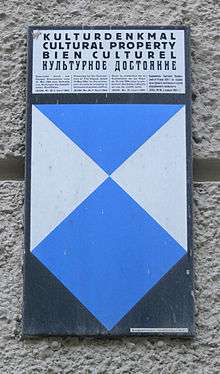Cultural property
Cultural property are physical items that are part of the cultural heritage of a group or society.[1] They include such items as historic buildings, works of art, archaeological sites, libraries and museums.

Plaque of the Bundesdenkmalamt on a building in Salzburg indicating "Cultural property" in four languages; German: Kulturdenkmal, English, French: Bien culturel, and Russian: Культурное Достояние.
Legal protection of cultural property comprises a number of international agreements and national laws. There is intensive cooperation between the United Nations, UNESCO and Blue Shield International on the protection of cultural goods.[2][3][4]
Definition
Article 1 of the Hague Convention for the Protection of Cultural Property in the Event of Armed Conflict of 1954 defines cultural property as follows:[5]
- "The term 'cultural property' shall cover, irrespective of origin or ownership:
- (a) movable or immovable property of great importance to the cultural heritage of every people, such as monuments of architecture, art or history, whether religious or secular; archaeological sites; groups of buildings which, as a whole, are of historical or artistic interest; works of art; manuscripts, books and other objects of artistic, historical or archaeological interest; as well as scientific collections and important collections of books or archives or of reproductions of the property defined above;
- (b) buildings whose main and effective purpose is to preserve or exhibit the movable cultural property defined in sub-paragraph (a) such as museums, large libraries and depositories of archives, and refuges intended to shelter, in the event of armed conflict, the movable cultural property defined in sub-paragraph (a);
- (c) centers containing a large amount of cultural property as defined in sub-paragraphs (a) and (b), to be known as 'centers containing monuments'."
Emblem

The Blue Shield is a symbol of protection that identifies cultural property to be protected in the event of armed conflict and those responsible for protecting it: its use is restricted under international law. The 1954 Hague Convention for the Protection of Cultural Property in the Event of Armed Conflict describes the logo and lays down conditions for its use.
Article 16 of the Convention describes the internationally recognized mark for cultural property as follows:
- (1) The distinctive emblem of the Convention shall take the form of a shield, pointed below, persaltire blue and white (a shield consisting of a royal-blue square, one of the angles of which forms the point of the shield, and of a royal-blue triangle above the square, the space on either side being taken up by a white triangle).
- Use of the Emblem is restricted under international humanitarian law. Guidance for using the emblem is available from The Blue Shield, and UNESCO.
See also
- Heritage site
- World Heritage Site
- National Heritage Site
- National Monument
- Philippine Registry of Cultural Property
- National Commission for Culture and the Arts
References
- Ann Marie Sullivan, Cultural Heritage & New Media: A Future for the Past, 15 J. MARSHALL REV. INTELL. PROP. L. 604 (2016) https://repository.jmls.edu/cgi/viewcontent.cgi?article=1392&context=ripl
- "UNESCO Legal Instruments: Second Protocol to the Hague Convention of 1954 for the Protection of Cultural Property in the Event of Armed Conflict 1999".
- Roger O’Keefe, Camille Péron, Tofig Musayev, Gianluca Ferrari "Protection of Cultural Property. Military Manual." UNESCO, 2016, S. 73ff.
- UNESCO Director-General calls for stronger cooperation for heritage protection at the Blue Shield International General Assembly. UNESCO, 13 September 2017.
- Convention for the Protection of Cultural Property in the Event of Armed Conflict with Regulations for the Execution of the Convention 1954 at the UNESCO website
This article is issued from Wikipedia. The text is licensed under Creative Commons - Attribution - Sharealike. Additional terms may apply for the media files.